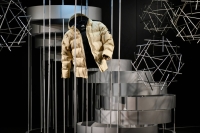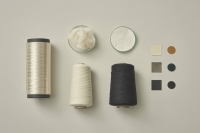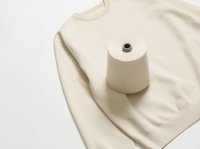The models cut modern silhouettes and wear broody expressions in their sleek, monochrome outfits. They glide their hands mysteriously and smolder at the camera. Interspersed are images of icebergs.
The campaign that promotes Goldwin and Spiber’s offerings looks much like any other piece of fashion advertising, but peer closer and descriptions of “brewed” materials offer a hint into its differences.
The partnership between Goldwin, a sportswear manufacturer, and Spiber, a biotech company based in Yamagata Prefecture, is one of a number of collaborations between the fashion and biotechnology sector aimed at reducing the former’s massive environmental impact.
A crop of scientists and fashion tech pioneers are increasingly looking to nature for clues as to how to develop materials that can be broken down and reused more easily, and mitigate environmental harm. From developing yeast and bacteria to color fabric, to lab-grown fibers derived from algae and taking inspiration from the structure of mushrooms and spiderwebs, the intricate patterns and proteins found in organic materials remain a source of wonder, even to those well-versed in the use of such cutting-edge technology.
At the same time, the fashion industry is under increasing pressure to innovate and find sustainable alternatives in order to minimize its environmental impact — even pattern-cutting has become more strategic as designers look to cut down on cumulative wastage.
Data from the U.N. Environment Programme and the Ellen MacArthur Foundation, a U.K.-based nonprofit focused on reusing products, shows that around 20% of wastewater worldwide stems from fabric dyeing and treatment, and the fashion industry as a whole uses 93 billion cubic meters of water annually — representing 4% of global freshwater withdrawal.
And there is a climate change impact too, with estimates of the industry’s emissions ranging from 2% of the global annual total, according to the Apparel Impact Institute, to the 10% figure calculated by the UNEP and Ellen MacArthur Foundation — the latter putting fashion’s impact above that of international flights and maritime shipping combined.
Plastic-based fibers like nylon, acrylic and polyester are both energy intensive, with their production driving up emissions, and also major contributors of microfiber plastics found in oceans — an area of growing concern for scientists.
Looking to nature
Hoping to turn the tide is Japan’s Spiber, a rare “unicorn” startup in the country. In recent years, the company, which produces spun materials similar to cashmere through lab-grown and plant-based fibers which undergo a microbial fermentation — or brewing — process, has worked with multiple companies, with collaborators including luxury Japanese fashion brand Sacai and California-headquartered Ron Herman.
Spiber is a portmanteau of “fiber” and “spider,” with the brand originally taking inspiration from spiderwebs when it was founded in 2007. Company founders ventured out to catch spiders and analyze their DNA as part of an effort to replicate spiders’ silk genes and see if microbes could reproduce spider silk.
The company’s offering — which it calls Brewed Protein — is now fundamentally different after it was discovered that garments made from spider silk protein shrunk dramatically — a quality shared with actual spiderwebs.
“What we're making today is not spider silk. It's not the same as any natural material,” says Kenji Higashi, executive vice president of business development, sales and sustainability.
Compared with Mongolia-origin cashmere, Spiber’s Brewed Protein fibers use 94% less water and contribute 97% less habitat damage, according to the company’s 2022 sustainability impact report, which also found their products have lower associated carbon emissions. But the report also found that Spiber contributed an “increased environmental impact in some other areas compared to equivalent animal-derived products,” including in terms of electricity and consumption of petroleum products, which the company says it is trying to deal with.
Goldwin, which has the trademark right of The North Face brand in Japan, has an eight-year relationship with Spiber, which began in 2015 when the two companies collaborated on a prototype of The North Face Moon Parka using Spiber-produced protein material that mimicked the properties of spider silk. In 2019, after further refinement, the companies were able to solve issues such as the shrinkage and commercialize the Moon Parka.
Goldwin, which aims to have 10% of its newly developed products use Brewed Protein by 2030, is clearly excited by the product.
Gen Arai, development manager at Goldwin, said that until now, sports apparel products have typically been made using petroleum-based synthetic polymers such as polyester and nylon.
“This is because there was no other option to achieve the functionality, light weight and durability required for such products,” Arai says.
Concern over the environmental impact of petroleum-derived materials was a concern for the company, Arai says, because of their emission of microplastics.
“In addition, the ongoing depletion of crude oil is raising the need to switch to sustainable resources,” Arai says, noting that while recycling technologies for polyester and nylon are advancing, and the variety of recyclable materials is increasing, “we don’t believe these are adequate for achieving a fundamental solution.”
This is what motivated the company to focus on “structural protein fiber, a sustainable material that can recirculate within the biosphere, and begin joint research and development of it with Spiber,” Arai says.
A few high-profile labels have succeeded in incorporating biotechnology materials in their product lines. Stella McCartney works with California biotech company Bolt Threads, which manufactures silk-like products similarly inspired by spiderwebs, while Hermes has collaborated with MycoWorks to develop a biotech version of its Victoria handbag using mycelium to create “mushroom leather.”
Although Ananas Anam, which developed Pinatex as a byproduct of pineapple harvesting, has entered into relationships with H&M and Nike, most notable examples of biotechnology in the fashion world occur in the luxury segment, in part due to the high costs associated with the production and development of the materials.
Still, a 2021 paper by researchers at the Queensland University of Technology stated that fashion “appears to be on the cusp of a biotechnological revolution,” driven by pressing environmental concerns.
Chetna Prajapati, lecturer in textiles at Loughborough University in Britain, says that in this space, the bulk of energy and efforts is being put into synthetic biology, with scientists examining bacteria and fungi in order to understand their DNA and how it can be manipulated to pursue “a sort of biomimicry” inspired by nature.
Much of biotechnology stems from mimicking materials that already exist, and “in the process of this, companies are finding that these new materials have new possibilities,” she says, rather than setting out to develop new, potentially “foreign” materials.
“I think there's a lot of work to be done with regards to consumer acceptance and educating consumers on some of these new materials and the possibilities,” Prajapati says, noting that building a narrative about the environmentally friendly qualities and utilizing storytelling “is a really important part” of the process.
Cost issues
Developing a narrative that will engage consumers and attract financial and brand backing is a key challenge for the biotech industry.
Prajapati notes that lack of investment in biotech companies is currently a major barrier to them taking their products mainstream.
“I think there's lots of innovation out there,” she says, but adds that there needs to be greater efforts to support the development of these technologies commercially, including from the government level.
“That’s the biggest barrier to taking some of these fantastic technologies out of the lab and piloting them, and them going commercial ... because we don't have a lack of ideas,” she says.
While Spiber tries to spin its products into mainstream staples, cost remains the primary hurdle to competing with traditional fabric manufacturers. The company hopes that recently opened factories will enable it to bolster production.
Still, mass production is another matter for the company, which will be tasked with proving its product is a commercially viable and compelling alternative — and that its sustainability and circular lifespan are worth paying for.
“If you compare our materials to materials like cotton or wool, our materials are still a lot more expensive,” Higashi says, conceding that, at present, it’s easier for luxury brands to accommodate the higher price point.
Arai also noted this was a consideration for customers.
“Admittedly ... customers have shown their concern about the higher prices,” he says, but noted that, “The previous limited-edition apparel sold out on the day they launched, and excitement over these new products is growing.
“Our overseas partner companies also have high expectations,” he says.
Spiber is equally ambitious — they are banking that their expanded production facilities will enable them to produce materials in greater quantities and scale down costs and make their product more accessible to a mainstream audience.
“We do intend to supply to the world,” Higashi says.
The company is planning to establish a manufacturing plant in Iowa in the U.S. Midwest, which will follow the start of production at its Thailand plant in 2022. The locations were selected in part because of government support and access to agricultural materials.
With global expansion on the cards, the brand will “need to look at other locations as well,” Higashi says.
Arai is also optimistic that expanded production will bolster the brands harnessing the technology.
With Spiber’s Thailand plant “reaching full-scale operation, we have been able to increase the number of brands and items made with Brewed Protein for our fall/winter 2023 collection and initiate global sales of selected brands,” he says.
One piece of the puzzle
Still, new fabrics and technological innovations are just part of the equation — the thinking of consumers and brands is also something sustainability advocates say needs to change.
A 2021 Apparel Impact Institute report found that while scaleable next-generation materials could contribute 13% of the reductions needed for the fashion industry to reach net zero by 2050, larger contributions would come from phasing out coal and making gains in material efficiency, waste reduction and the usable life of garments.
Because of this, shifting consumer behavior away from the dizzying cycle of fast fashion, fueled by social networks, is another area for concern. Fast-fashion retailer Shein, for example, launches thousands of low priced new products every day, and produces items based on social media-driven demand.
In order to deliver real impact, brands and suppliers need to enhance end-of-use recycling and collaborate with policymakers, McKinsey’s Fashion on Climate 2020 report found.
Prajapati says that examining how to better break up textiles, which are typically made up of various components including elastane, polyester and natural fibers like wool, and reuse these materials is an important issue for the industry.
“The work that I do looks at how we might use biotechnology to break those components up, separate them and then hopefully, use the dye that's extracted, use the wool that's extracted, and the polyester and then put them back into new textiles,” she says. In some situations, they could be repurposed in other ways, she says.
While “technology definitely has a part to play and it enables us to be more efficient with our resources, and how we design products for consumption,” shifts in behavior are also critical, Prajapati says. “Mindset changes, consumer behavior, slowing down consumption ... there’s a balance that we need to find.
“It's really exciting with some of the concepts that researchers are hopefully trying to make mainstream and accessible,” she says. “But at the same time, it's only a small part of the jigsaw puzzle.”































With your current subscription plan you can comment on stories. However, before writing your first comment, please create a display name in the Profile section of your subscriber account page.